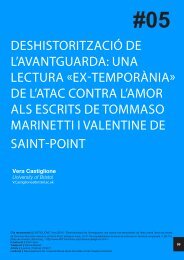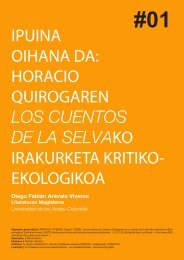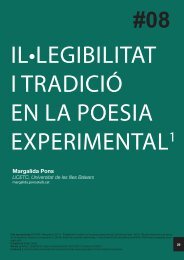03 - 452ºF
03 - 452ºF
03 - 452ºF
Create successful ePaper yourself
Turn your PDF publications into a flip-book with our unique Google optimized e-Paper software.
What was the barn like before it was photographed? he said. What did<br />
it look like, how was it different from other barns, how was it similar to<br />
other barns? We can’t answer these questions because we’ve read the<br />
signs, seen the whole people snapping the pictures we can’t get outside<br />
the aura. We’re here, we’re now. (DeLillo, 1985: 13)<br />
Murray’s final words «we’re here, we’re now» can be interpreted as<br />
that the main impact of the era of simulation on everyday life is that<br />
it eradicates any sense of past or future. According to Baudrillard in<br />
his famous book America (1986), people, especially in contemporary<br />
America, live in «a perpetual present…in a perpetual simulation, in a<br />
perpetual present of signs» (Baudrillard, 1986: 18).<br />
One of the major issues that DeLillo depicts in White Noise is the<br />
emergence of the consumer culture in the postwar, postindustrial<br />
society. Consumption, in this new culture, has gained a new different<br />
meaning. People no longer buy goods for their use-value, or because<br />
they are in need; on the contrary, as we see in the novel, people shop<br />
because they feel an ecstasy caused by the spectacle of the goods.<br />
The supermarket, the mall, and the hypermarket have become a<br />
Mecca for consumers in postmodernity.<br />
In the new consumer culture, the experience of the real has faded<br />
away and reality is struggling to death. The supermarket offers open<br />
spaces, meticulous designs, bright colors, all goods of all kinds, and all<br />
these create «the spectacle» which seduces or entices the consumer<br />
into buying even if they don’t have any intention to buy. According<br />
to Baudrillard, the supermarket «goes far beyond consumption, and<br />
the objects no longer have a specific reality there: what is primary is<br />
their serial, circular, spectacular arrangement» (DeLillo, 1985: 55). In<br />
the opening pages of White Noise, Denise and Steffie argue about<br />
Babette’s habit of buying things she doesn’t need or even eat. Denise<br />
says that, «she thinks if she keeps buying it, she’ll have to eat it just<br />
to get rid of it. It’s like she’s trying to trick herself» (DeLillo, 1985: 7).<br />
In consumer culture, it starts to be «shopping for shopping’s sake,»<br />
and this is exactly what we hear from Jack when he shops with his<br />
family at the mall, when he felt so «expansive» because he shops.<br />
He says, «I shopped for its sake, looking and touching, inspecting<br />
merchandize I had no intention of buying, then buying it» (DeLillo,<br />
1985: 84).<br />
Like the TV screen, the supermarket is the venue where the image<br />
and the simulacra have declared their triumph over reality. Shoppers<br />
are attracted to colors, sizes, and the packaging; the surface is what<br />
draws and grips their attentions and ignites their desires to buy items<br />
regardless of their need for them. While in the supermarket Murray<br />
notes that:<br />
Living in a simulacrum: how TV and the supermarket redefines reality in Don DeLillo’s White noise - Ahmad Ghashmari<br />
<strong>452ºF</strong>. #<strong>03</strong> (2010) 172-186.<br />
181










